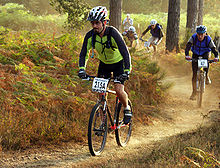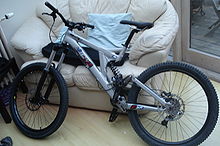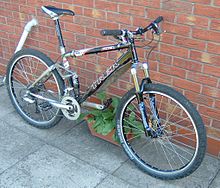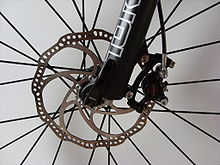- Mountain bike
-
This article is about mountain bikes themselves. For the associated activity, see Mountain biking.
A mountain bike or mountain bicycle (abbreviated MTB or ATB (all-terrain bicycle)) is a bicycle created for off-road cycling. This activity includes traversing of rocks and washouts, and steep declines, on dirt trails, logging roads, and other unpaved environments—activities usually called mountain biking. These bicycles need to be able to withstand the stresses of off-road use with obstacles such as logs and rocks. Most mountain bikes use wheels with rims which are 559mm in ISO sizing, colloquially referred to as "26-inch", although the term is inaccurate as it covers too many rim and tire sizes to be meaningful. Wheels used on mountain bikes usually use wide, knobby tires for good traction on uneven terrain and shock absorption. Since the mid-1990s, front wheel suspension has become the norm and since the late 1990s, full front and rear suspension has become increasingly common. Some mountain bikes are also fitted with bar ends on the handlebars to give extra leverage for hill-climbing.
Since the development of the sport in the 1970s many new subtypes of mountain biking have developed, such as cross-country (XC) biking, all-day endurance biking, Freeride-biking, downhill mountain biking, and a variety of track and slalom competitions. Each of these place different demands on the bike requiring different designs for optimal performance. MTB development has included an increase in gearing, up to 30 speeds, to facilitate both climbing and rapid descents. Other developments include disc instead of rim brakes.
Contents
History
Main article: History of the mountain bike and mountain bikingThe history of the mountain bike includes contributions from cyclo-cross in Europe and the Roughstuff Fellowship[1] in the UK. The name "mountain bike" first appeared in print in 1966 as "mountain bicycle". The mountain bike was a modified heavy cruiser bicycle used for freewheeling down mountain trails. The sport became popular in the 1970s in Marin county, California, USA. The 2007 documentary film, Klunkerz: A Film About Mountain Bikes, looks at this period of off-road cycling in detail. However, it was not until the late 1970s and early 1980s that road bicycle companies started to manufacture mountain bicycles using high-tech lightweight materials, such as M4 aluminium, although in recent years, titanium and carbon fiber frames have become more common but can be very expensive. The first mass production mountain bike was the Specialized Stumpjumper, first produced in 1981.[2] Throughout the 1990s and 2000s, mountain biking moved from a little-known sport to a mainstream activity.
Designs
Mountain bikes can be classified into four categories based on suspension:
- Fully rigid: A frame with a rigid fork and fixed rear, no suspension.
- Hardtail: A frame with a front suspension fork and no rear suspension.
- Soft tail: A frame with small amount of rear suspension, activated by flex of the frame instead of pivots.
- Dual or full suspension: A front suspension fork and rear suspension with a rear shock and linkage that allow the rear wheel to move on pivots.
Discipline-oriented designs
There are several different styles of mountain biking, usually defined by the terrain, and therefore bikes employed. Styles of mountain bike riding and mountain bikes have evolved rapidly in recent years leading to terms such as Freeride and "Trail bike" being used to categorise mountain bikes. Definitions for the most widely used terms are listed below.
Cross country (XC) mountain bikes are designed primarily around the discipline of cross country racing. Cross country racing with its emphasis on climbing as well as speed and endurance demands bikes that are both lightweight and efficient. In the 1980s and early 1990s XC mountain bikes typically consisted of a lightweight steel hardtail frame with rigid forks. Throughout the 1990s XC bikes evolved to incorporate lightweight aluminium frames and short travel (65 to 110mm) front suspension forks. Recently full suspension designs have become more prevalent, the use of advanced carbon fiber composites has allowed bike designers to produce full suspension designs under 10 kg. Full suspension bikes such as the Specialized Epic and the Mérida Ninety Two have been successfully used to win the World Cross Country Championships. The geometry of Cross Country bikes favours climbing ability and fast responses over descending and stability and as a result typical head angles are 70-71o Although intended for off-road use, Cross Country mountain bikes with their emphasis on lightweight construction are not designed for use on the most steep or severe terrain.
"Trail" Bikes are a development of XC bikes that are generally used by recreational mountain bikers either at purpose built "Trail centers" or on natural off-road trails. They usually have around 5" (120-140mm) of travel, weigh 11 to 15 kilograms (24 to 33 lb) , and have geometries slightly slacker than XC bikes, though not as slack as AM bikes. Examples include The Giant Trance, the Trek Fuel EX series, the Specialized Stumpjumper FSR, and others. With less of an emphasis on weight, Trail Bikes are typically built to handle rougher terrain than dedicated XC bikes while having slacker head angles (69-680) which provides greater stability while descending.
Enduro/all-mountain (AM) bikes bridge the gap between cross-country and freeride bikes, such as the Trek Remedy series, Specialized enduro, typically weighing between 13 to 16 kilograms (29 to 35 lb). These bikes tend to feature greater suspension travel, frequently as much as 6 inches (150 mm) or 7" of front and rear travel, often adjustable on newer mid- and high-end bikes. They are designed to be able to climb and descend well, these bikes are intended to be ridden on all-day rides involving steep climbs and steep descents, hence the term 'all-mountain'.
Downhill (DH) bikes typically have eight or more inches (200 mm) of suspension travel. They are built with frames that are strong, yet light, which often requires the use of more expensive 78alloys. In the past few years, lighter downhill bikes have been getting below the 40 lbs mark (18 kg). Due to their typically large or high gears, long, plush travel and slack geometry angles, Downhill bikes are ideal only for riding down dedicated downhill trails and race courses. Downhill bikes have the most sag of Mountain Bikes to get ample traction to go fast over bumpy trails. Head Angles are often as slack as 63 degrees. Several types of bicycle speed records have been registered downhill. Due to the high-speed nature of downhill riding most bikes only have one chain ring in the front, a large bash guard and a chain guide, though many racers are now using chain guides without bash guards to reduce weight. Some of the most up to date designs feature internal gearboxes built directly into the frame construction, this modification eliminates the need for the rear derailleur mechanism, although this design has not been widely embraced yet.
Freeride (FR) mountain bikes are similar to downhill bikes, but with less emphasis on weight and more on strength. Freeride bikes tend to have ample suspension and typically have at least 7 inches (180 mm) of travel. The components are built from stronger, consequently heavier, materials. They can be ridden uphill, but are inefficient and their moderately slack head tube angles make them difficult to maneuver while angled up a hill or traveling at a low speed. They are effective on technical downhill trails. Frame angles are typically steeper than those found in downhill bikes. This enhances maneuverability over and around small objects. Freeride bikes typically range in weight from 14 to 20 kilograms (31 to 44 lb). The most durable freeride bikes are often too heavy and have too much suspension to be ridden uphill as comfortably as other less-sturdy models, although newer, more expensive bikes come with suspension specifically designed to make them easier to ride uphill.
Trials bikes are set up very specifically for the purpose of bicycle trials. Two varieties of trials bike exist, those with 26" wheels (referred to as 'stock') and those with 20" wheels (referred to as 'mod' - because historically they were modified BMX bikes). They typically have no suspension at all, though some still make use of some form of it. Competition rules require stock bikes to have multiple gears for competition, but most riders never use their shifters. Competition rules do not require mod bikes to have any gears. Many non-competitive riders run single-speed, choosing a fairly low-speed, high-torque gear. Most modern trials bikes have no seat at all, as the rider spends all of his time out of the saddle. These bikes are significantly lighter than almost all other mountain bikes, ranging from 7 to 11 kilograms (15 to 24 lb). This makes maneuvering the bike much easier.
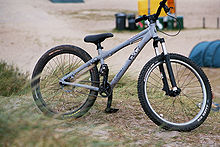 A simple dirt jump bike.
A simple dirt jump bike.
Dirt jumping, urban and street mountain bikes lie somewhere in between a BMX bike and a freeride bike. They are typically very strong bikes, with 4 to 6 inches (100 to 150 mm) of front suspension, and rarely any rear suspension (3 to 4 inches, 76 to 100 mm, if any), with as many as nine gears or as few as one. Tires on these bikes are usually fast-rolling, slick or semi-slicks. Dirt Jumpers usually sport a geometry of 24-26" tires, as well as a bashring (a type of bashguard) replacing the largest ring on the crankset. Dirt jumpers usually have low seatposts and oversized handlebars. Most dirt jumpers have an extended rear brake cable installed and have no front brake, which allows the rider to spin the handle bars without tangling the brake cables.
Single-speed (SS) mountain bikes have one set gear ratio. The gear ratio chosen depends on the terrain being ridden, the strength and skill of the rider, and the size of the bike (a bike with 29" wheels often requires a different gearing than a bike with standard 26" wheels). Often single-speeds are fully rigid, steel-framed bikes. These are typically ridden by very fit individuals on mild to moderate cross country terrain.
Mountain cross or "Four-cross" (4X) is a relatively new style of riding where four bikers race downhill on a prepared, BMX like, track, simply trying to get down first. These bikes are generally either full suspension with 3 to 4 inches (76 to 100 mm) of travel, or hardtails, and have, typically, quite strong frames. They run a chainguide on front and gears on the back. They have slack head angles, short chainstays and low bottom brackets to aid in cornering and acceleration.
Dual slalom (DS) is similar to Four-cross, but instead of four competing cyclists during a race, there are only two. Courses usually have a lane for each rider, though some combine to a single lane in places or even for much of the course. The courses are in general more technical with smaller jumps than Four-cross courses. Dual Slalom races originally took place on grass slopes with gates and minimal jumps, but are now held on man-made courses. Dual slalom riders will usually use the same bikes that Four-cross riders use.
Short cross or speed cross (SC) is the newest form of mountain biking. The idea is to ride short, narrow forest paths with rocks and roots, but not necessarily any ramps on them. The optimal length of the paths are from a few tens to hundreds of meters. The shortness is to provide extreme speed and thrill to get through the hindrances as fast as possible without crashing. The altitude of each path does not have to vary much. The ultimate direction of each path from vertical aspect can be either up or down. The transitions between these essential parts are to be taken lightly and stopping at the beginning of every path is to provide maximum amount of thrilling action gained through the speed. The best fitting bicycle for SC is probably lightweight, but long travel full suspension bike.
Indycross (IX) is essentially a Mountain Cross event featuring a wide variety of features run by one competitor per time.[3]
North Shore bikes are much like freeride bikes in their geometry and downhill bikes in their component makeup. Because north shore stunts have evolved to not only include simple and complex bridges but also large drops and high-speed descents through a series of stunts north shore bikes commonly have as much travel as downhill and freeride bikes, however with much more nimble and maneuverable frame designs, and often lighter weight.
Circle dirt track racing In this class of racing any kind of bikes are used, most commonly a hard tail mountain bike with front suspension. Many different modifications are made to track racing bikes, such as reducing bike weight, increasing brake power, trying different cambers (so that when the bike leans the tire is more level with the track thus creating more grip), and trying different gear ratios.
It should be noted that in the early days of mountain biking, all mountain bikes were somewhat custom, homebuilt machines, and were used for any number of stunts, tricks, racing or other activities. The general design of the bikes were similar. As the sport grew, more specialized designs and equipment were introduced. The further market segmentation beyond simple front suspension XC began to occur in the mid 90s, as large bicycle and equipment manufacturers were able to cater specifically to changing demands.
Modern designs
In the 2000s, mountain bikes often use frames designed for off-road use, which are strengthened to withstand jumps and impacts and which use a geometry that allows for much more spirited riding over obstacles like logs, rocks, and ramps. In the 2000s, mountain bikes often have either 21, 24, or 27 speeds, with 3 gears in the front and 7, 8, or 9 gears at the rear wheel. Thirty-speed mountain bikes have previously been unworkable, as the mud-shedding capabilities of a ten-speed cassette, and the intricacies of a ten-speed rear derailleur have never been suitable. However, many pro-level mountain bikers have taken to using a narrower 10-speed road chain with a 9-speed setup in an effort to reduce the weight of their bike. In early 2009, component group SRAM announced their release of their XX groupset, which uses a two-speed front derailleur, and a ten-speed rear derailleur and cassette, similar to that of a road bike. Mud-shedding capabilities of their ten-speed XX cassette are made suitable for MTB use by extensive CNC machining of the cassette. Due to the time and cost involved in such a product, they were only aimed at top-end XC-racers. However, 10-speed has become the norm by 2011 and the market leader Shimano even offers it's budget groupset "Alivio" in a 10-speed version.
Geometry
Main article: Bicycle frame geometryThe critical angles in bicycle geometry are the head angle (the angle of the head tube), and the seat tube angle (the angle of the seat tube). These angles are measured from the horizontal, and drastically affect the rider position and performance characteristics of the bicycle. Mountain bike geometry will often feature a seat tube angle around 73 degrees, with a head tube angle of anywhere from 60-73 degrees. The intended application of the bike affects its geometry very heavily. In general, steeper angles (closer to 90 degrees from the horizontal) are more efficient for pedaling up hills and make for sharper handling. Slacker angles (leaning farther from the vertical) are preferred for high speeds and downhill stability.
Suspension
Main article: Bicycle suspensionIn the past mountain bikes had a rigid frame and fork. In the early 1990s, the first mountain bikes with suspension forks were introduced. This made riding on rough terrain easier and less physically stressful. The first suspension forks had about 1½ to 2 inches (38 to 50 mm) of suspension travel. Forks are now available with 8 inches (200 mm) of travel or more (see above under "Design.") Bikes with front suspension and rigid, non-suspended rear wheels, or hardtails became popular nearly overnight. While the hardtail design has the benefits of lower cost, less maintenance, and better pedaling efficiency, it is slowly losing popularity due to improvements in full suspension designs.
Many new mountain bikes integrate a "full suspension" design known as Dual Suspension or "full-susser", meaning that both the front and rear tire are fitted with a shock absorber in some form as the wheel attaches to the bike to provide a smoother ride as the front and rear wheels can now travel up and down to absorb the force of obstacles striking the tires. Dual suspension bikes of a similar quality are considerably more expensive, but this price increase brings an enormous off-road performance upgrade as dual suspension bikes are much faster on downhill and technical/rough sections, than other forms of the mountain bike. This is because when the wheel strikes an obstacle its tendency is to bounce up. Due to some forward energy being lost in the upward movement some speed is lost. Dual Suspension bikes solve this problem by absorbing this upward force and transmit it into the shocks of the front and rear wheels, drastically decreasing the translation of forward momentum into useless upward movement. Many bikes have dual suspension including downhill, freeride and mountain, although some bikes are built only to have front suspension e.g. dirt jump, some mountain. This makes them lighter and easier to control while in motion.
Disadvantages of rear suspension are increased weight, increased price, and with some designs, decreased pedaling efficiency, this is especially noticeable when cycling on roads and hard trails. At first, early rear suspension designs were overly heavy, and susceptible either to pedaling-induced bobbing or lockout at certain points of the suspension arc or travel, this is still the case of many bottom end bikes. One of the most popular rear suspension designs to solve these issues has been the 'Horst Link' which first appeared with the AMP series of bikes, and was later adopted by Specialized and many other mountain bike manufacturers.
Disc brakes
For further information see Bicycle brake systems. For general information see Disc brake.While inexpensive department store-style mountain bikes often come with V-brakes, most higher-end mountain bikes produced since the mid-2000s use disc brakes. These offer improved stopping power over rim brakes under adverse conditions, because they are located at the center of the wheel (on the wheel hub) and therefore remain drier and cleaner than wheel rims, which are more readily soiled or damaged. The disadvantage of disc brakes is their increased cost and often greater weight.
Wheel and tire design
Most mountain bikes use 26-inch (559 mm) bicycle wheels, though some models offer 24 or 29 inch (520 or 622 mm) wheels. Bicycle wheel sizes are not precise measurements: a 29 inch mountain bike wheel actually has a 622 millimetres (24.5 in)) bead seat diameter (the term, bead seat diameter (BSD), is used in the ETRTO tire and rim sizing system). 622 mm wheels are standard on road bikes and are commonly known as 700c. In some countries, mainly in Continental Europe, 700c (622 mm) wheels are commonly called 28 inch wheels.[4] 24 inch wheels are used for dirt jumping bikes and sometimes on freeride bikes, rear wheel only, as this makes the bike more maneuverable. 29 inch wheels were once used for only Cross Country purposes, but are now becoming more commonplace in other disciplines of mountain biking. A mountain bike with 29" wheels is often referred to as a 29er. Wheels come in a variety of widths, ranging from standard rims suitable for use with tires in the 26 in x 1.90 in to 2.10 in (559 x 48 to 53 mm) size, to 2.35 and 3.00 in (60 and 76 mm) widths popular with freeride and downhill bicycles. Although heavier wheelsets are favored in the freeride and downhill disciplines, advances in wheel technology continually shave weight off strong wheels. This is highly advantageous as rolling weight greatly affects handling and control, which are very important to the technical nature of freeride and downhill riding. The widest wheel widths are sometimes used by icebikers who use their mountain bikes for winter-time riding in snowy conditions.
Manufacturers produce bicycle tires with a wide variety of tread patterns to suit different needs. Among these styles are: slick street tires, street tires with a center ridge and outer tread, fully knobby, front-specific, rear-specific, and snow studded. Some tires can be specifically designed for use in certain weather (wet or dry) and terrain (hard, soft, muddy, etc.) conditions. Other tire designs attempt to be all-around applicable. Within the same intended application, more expensive tires tend to be lighter and have less rolling resistance. Sticky Rubber tires are now available for use on freeride and downhill bikes. While these tires wear down more quickly, they provide greater traction in all conditions, especially during cornering. Tires and rims are available in either tubed or tubeless designs, with tubeless tires recently (2004) gaining favor for their pinch flat resistance. Tubeless tires can also be run at lower air pressures to improve traction and increasing rolling resistance. Popular tire manufacturers include Wilderness Trail Bikes, Schwalbe, Maxxis, Nokian, Michelin, Continental, Tioga, Kenda, Hutchinson Specialized and Panaracer.
Tandems
Mountain bikes are available in tandem configurations. For example, Cannondale and Santana Cycles offer ones without suspension, while Ellsworth, Nicolai, and Ventana manufacture tandems with full suspension.
See also
- Bicycle
- Freeride mountain-biking movies
- International Mountain Bicycling Association
- List of bicycle manufacturers
- Mountain unicycling
- National Off-Road Bicycle Association (NORBA)
- Mountain quadracycle
- Transrockies
- UCI Mountain Bike & Trials World Championships
References
- ^ Steve Griffith. "Off Road Origins". Rough Stuff Fellowship. http://www.rsf.org.uk/history.htm. Retrieved 2010-06-18.
- ^ Rogers, Seb (23 October 2010). "Interview: Specialized founder Mike Sinyard". BikeRadar. http://www.bikeradar.com/news/article/interview-specialized-founder-mike-sinyard-28233. Retrieved 2 December 2010.
- ^ "Diablo Freeride Park". Archived from the original on 2008-05-03. http://web.archive.org/web/20080503100742/http://diablofreeridepark.com/indycross.html. Retrieved 2008-09-21.
- ^ "Sheldon Brown: Tire Sizing Systems". http://www.sheldonbrown.com/tire-sizing.html. Retrieved 2008-09-21.
Human-powered transport Land Pedal powerBicycle · Bicycle trailer · Cycle rickshaw · Freight bicycle · Mountain bike · Party Bike · Quadracycle · Recumbent bicycle · Road bike · Tandem bicycle · Trailer bike · Tricycle · Trikke · Unicycle · Velocar · Velocipede · VelomobileHand-powerRow-actionRowing cyclesFoot powerPushed/pulledBaby transport · Baggage cart · Gurney · Handcart · Hand truck · Pulled rickshaw · Shopping cart · Stairclimber · WheelbarrowCarriedWater Snow and ice Alpine touring skis · Crampons · Cross-country skis · Ice skates · Kicksled · Snowshoes · Telemark skis · Snowboard · SledAir Categories:- Cycle types
- Mountain biking
- Road cycles
- Racing vehicles
- Bicycles
- Off-road vehicles
Wikimedia Foundation. 2010.


